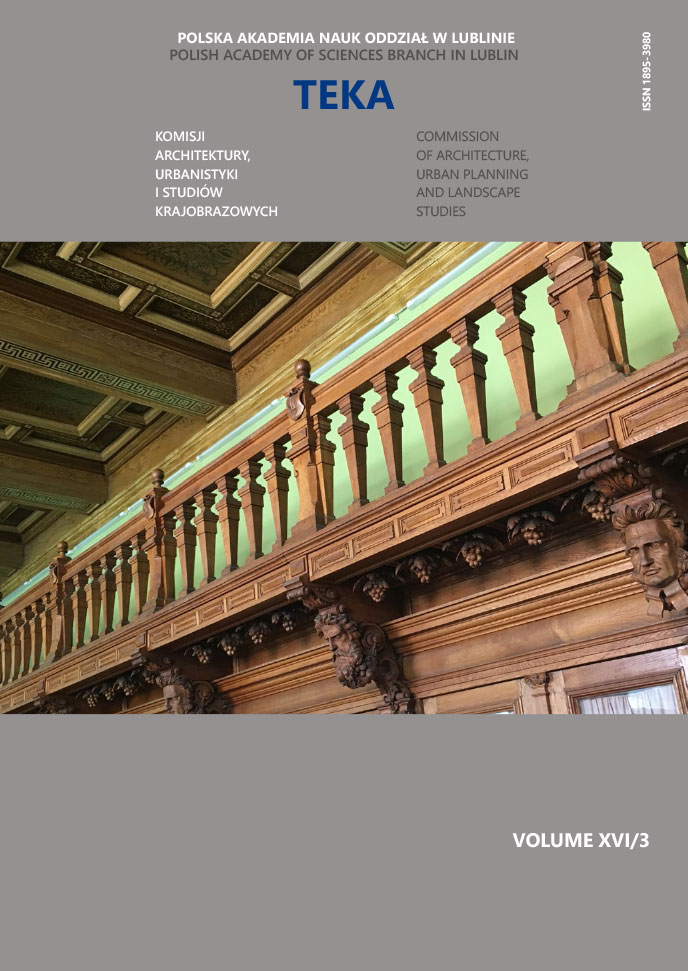Comparative method with the use of laser scanning as a starting point for the assessment of the state of preservation of the face of the walls in the Kłodzko Fortress
Article Sidebar
Open full text
Issue Vol. 16 No. 3 (2020)
-
Residential districts of the socialist realism period in Poland (1949−1956). Analysis, comparison and protection
Zuzanna Napieralska, Elżbieta Przesmycka7-18
-
Architecture of Polish water sports facilities located in parks in the interwar period
Wojciech Kocki19-23
-
The Truth in Architecture as a Synthesis of Material and Ideas – Brick Architecture of Białystok
Andrzej Tokajuk24-32
-
Adaptation and embedding of modern military objects on the example of the Kłodzko Fortress
Katarzyna Drobek33-41
-
Comparative method with the use of laser scanning as a starting point for the assessment of the state of preservation of the face of the walls in the Kłodzko Fortress
Piotr Gleń, Karol Krupa42-49
-
Architecture in the public space – streets and squares under the conditions of urban globalization
Dariusz Gaweł50-57
-
Surveing housing districts of Lublin: building types and energy performance
Anna Ostańska58-65
-
Architectural Methods of Protecting the Existing Trees in the City. Case Study
Wojciech Jabłoński66-73
-
Selected determinants of multi-family housing in Katowice in the 2030 perspective
Beata Komar74-83
-
Adaptation of form based code method in the Polish spatial planning system
Bartosz Kaźmierczak84-92
Archives
-
Vol. 18 No. 4
2022-12-30 5
-
Vol. 18 No. 3
2022-12-27 5
-
Vol. 18 No. 2
2022-12-27 5
-
Vol. 18 No. 1
2022-12-27 4
-
Vol. 17 No. 4
2021-12-30 11
-
Vol. 17 No. 3
2021-12-30 9
-
Vol. 17 No. 2
2021-12-30 8
-
Vol. 17 No. 1
2021-12-30 8
-
Vol. 16 No. 4
2020-12-30 11
-
Vol. 16 No. 3
2020-09-30 10
-
Vol. 16 No. 2
2020-06-30 11
-
Vol. 16 No. 1
2020-03-31 10
-
Vol. 15 No. 4
2019-12-30 6
-
Vol. 15 No. 3
2019-10-31 9
-
Vol. 15 No. 2
2019-06-28 12
-
Vol. 15 No. 1
2019-03-29 13
-
Vol. 14 No. 3
2018-10-28 14
-
Vol. 14 No. 2
2018-06-29 14
-
Vol. 14 No. 1
2018-03-30 13
Main Article Content
DOI
Authors
Abstract
This article presents architectural studies of the state of preservation of the face of the wall of the Kłodzko Fortress on the basis of the surveying works performed since 2016. These works include measurement of the entire fortress with the use of laser scanning. The analysis was carried out on the face of the wall, gradually degrading due to external factors and incorrect protection of the masonry. For detailed analysis, clouds of points from the period of 2 years (2017-2018) were used, taking into account the discussed northern part of the wall of the Great Tenaille (Wielkie Kleszcze). The paper explains the importance of the surveying process for the conservation works aiming at protection of the historical tissue from further degradation.
Keywords:
References
Gleń P., Krupa K., Comparative analysis of the inventory process using manual measurements and laser scanning, Budownictwo i Architektura 18(2) (2019)21−30 DOI: 10.35784/bud-arch.552. DOI: https://doi.org/10.35784/bud-arch.552
Rzonca A., Współczesne metody kompleksowej inwentaryzacji zabytków na przykładzie kościoła w Michalicach, w: Archiwum Fotorgametrii, Kartografii i Teledetekcji, Vol. 14, 2004.
Małachowicz E., Nowożytne fortyfikacje Śląska europejskim dziedzictwem kultury.
Jędrysiak T., Mikos von Rohrscheidt A., Militarna turystyka kulturowa, PWE, 2011.
https://www.dawnekłodzko.pl, accessed: 09.06.2020.
Decision KL-V-1/61/30 of 13th May 1960 about the entry to the Register of the Historic Monuments.
Małachowicz M., Twierdze Śląskie – 20 lat później, Fortyfikacje nowożytne w Polsce – badania, realizacje, projekty. Zagospodarowanie do współczesnych funkcji.
Mitka B., Usability of terrestrial laser scanners for the process of documentation and modeling of historical objects, in: Archiwum Fotogrametrii, Kartografii i Teledetekcji, Vol. 17b, 2007.
Remondino F., Heritage Recording and 3D Modeling with Photogrammetry and 3D Scanning, in: Remote Sensing 2011. DOI: https://doi.org/10.3390/rs3061104
D Laser Scanning of Heritage in: Historic England.
Gleń P., Krupa K., The use of secondary build-up in historical fabric based on the donjon of Kłodzko Fortress in: E3S Web of Conferences, 2018, vol. 49, DOI: https://doi.org/10.1051/e3sconf/20184900031. DOI: https://doi.org/10.1051/e3sconf/20184900031
Mikos v Rohrscheidt A., Turystyka Kulturowa, http://turystykakulturowa.org/, No. 2/2009.
Article Details
Abstract views: 230
License

This work is licensed under a Creative Commons Attribution-ShareAlike 4.0 International License.


